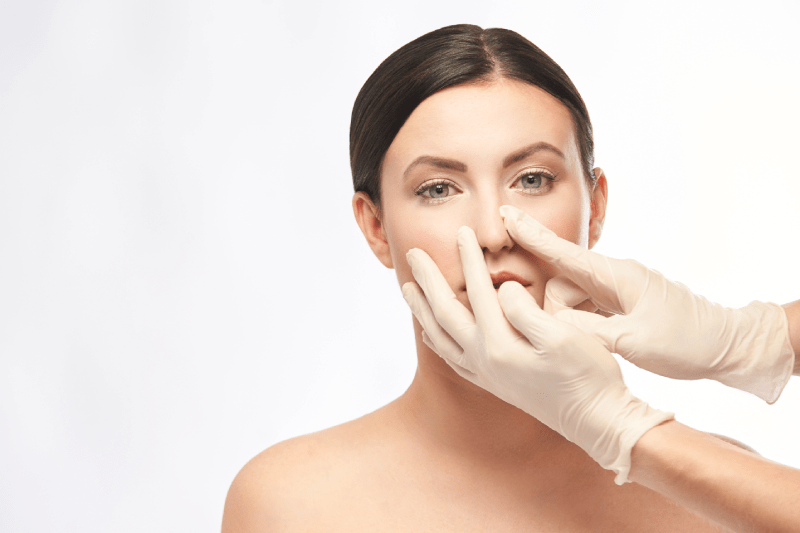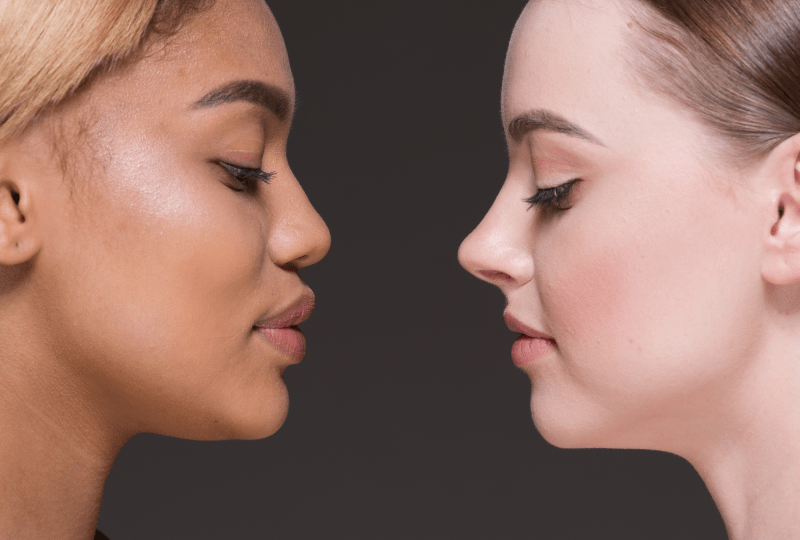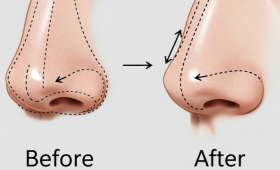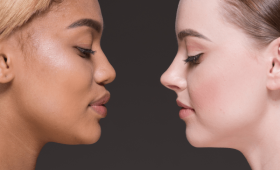What Is the Ideal Age for a Rhinoplasty?
The ideal age for a rhinoplasty is when the physical development of the nasal structure is complete. This is generally considered to be 17 years and older for girls, and 18 years and older for boys. These ages are a period when the growth of the nasal bone and cartilage structure has stopped, and the permanence of the surgical results is guaranteed. For operations performed due to aesthetic concerns, waiting for this physical maturity is of great importance for both the success of the surgery and the psychological well-being of the patient.
Can a Rhinoplasty Be Performed on Children?
Rhinoplasty for children is rarely performed for aesthetic purposes. Since the development of the nasal structure continues under the influence of growth hormones, aesthetic operations performed at these ages can negatively affect the future development of the nose and lead to undesirable results. However, in cases such as a broken nose or serious breathing problems, a surgical intervention may be performed with a doctor’s decision if the benefit of the operation outweighs the growth risks.
Is a Rhinoplasty Suitable for Elderly Patients?
A rhinoplasty is possible for elderly patients. In old age, changes such as a droopy nasal tip, widening of the bones, or thickening of the nasal skin may occur. These conditions can lead to both aesthetic and functional problems. The success of the surgery depends on the patient’s general health, skin elasticity, and the condition of the existing nasal structure. Patients aged 60 and over can have surgery as long as they do not have chronic diseases and are in a condition to tolerate the risks of anesthesia.
Why Must Nasal Development Be Completed?
The completion of nasal development is one of the most important criteria for a rhinoplasty. An operation performed before the development process is complete can inhibit the nose’s growth potential and compromise the results of the surgery. This situation can also cause the nose shape to change over time and lead to the need for a second surgery. Therefore, it is of vital importance to ensure that the nasal structure has reached full maturity before making the decision to undergo surgery.
How Does the Consent Process Work for Minors?
In Turkey, a rhinoplasty for aesthetic purposes on a minor cannot be performed without the written and signed consent of a parent or legal guardian. This consent is mandatory for the operation to be carried out in accordance with legal and ethical standards. Additionally, it must be confirmed by psychologists and doctors that the minor patient is truly willing to undergo the surgery and is psychologically ready for the process.
Is There an Upper Age Limit for a Rhinoplasty?
There is no definitive upper age limit for a rhinoplasty. What is important is that the patient’s general health condition is good enough to handle the surgery. Elderly patients with chronic diseases such as heart, lung, or diabetes are subjected to a more detailed health check due to the risks of anesthesia and surgical operations. The surgeon makes the final decision after evaluating the patient’s health status and the potential benefits of the operation.
What Are the Risks of an Early Age Operation?
The main risks of a rhinoplasty performed at an early age are the cessation of nasal development or its continuation in an abnormal way. This can lead to the nose shape changing over time, asymmetry, and functional problems. Additionally, young patients having unrealistic expectations about the surgical results can lead to psychological disappointment. Therefore, the decision to undergo surgery should be made by considering both physical and psychological maturity.
Should Rhinoplasty Be Considered During Adolescence?
Great caution should be exercised when considering a rhinoplasty during adolescence. Since nasal development continues during this period, the post-operative results may not be permanent. Furthermore, adolescence is a period when a person is searching for their identity and is sensitive about their physical appearance. The surgery can affect the psychological state during this process positively or negatively. Therefore, serious functional problems like difficulty breathing should be prioritized over aesthetic concerns.
How Important Is Psychological Preparation for a Rhinoplasty?
A rhinoplasty is not just a physical change but also a psychological process. It is very important for the patient to be psychologically ready to have realistic expectations about the surgical results, patiently face the recovery process, and adapt to their new appearance. The evaluation of young patients with a psychologist before the surgery can prevent possible disappointments.
How Does the Recovery Process Differ in Young Patients?
Since the metabolism of young patients works faster, their post-operative recovery processes are generally faster than in adults. Swelling and bruising subside in a shorter time, and tissue healing is completed more quickly. However, due to the social lives and school schedules of young people, psychological support and understanding become much more important during the recovery process. Parents must play a supportive role during this process.
How Does the Recovery Process Work in Elderly Patients?
In elderly patients, the post-operative recovery process may be slower than in young people. Due to the decrease in skin elasticity and the slowing of tissue regeneration, swelling and bruising may take longer to subside. The risks of infection and other complications that may occur during the recovery process can also increase with age. Therefore, elderly patients need to be under stricter medical supervision during the pre- and post-operative period.
Why Is the Best Age for a Rhinoplasty After 18?
The most important reason for preferring a rhinoplasty after the age of 18 is that the nasal bone and cartilage structure are fully developed after this age. This physical maturity ensures that the surgical results are permanent and do not change over time. Additionally, the age of 18 indicates a legal and psychological maturity where individuals can make their own decisions and take on the responsibilities of the surgery.
Can the Age Limit Be Relaxed for Minimal Changes?
In some cases, the age limit can be relaxed for minimal changes such as a tip plasty. If it is believed that the nasal tip has largely completed its growth and the patient has serious functional problems like difficulty breathing, the operation may be performed at an earlier age with the surgeon’s decision. However, this decision must be carefully evaluated by an expert surgeon and a multidisciplinary team.
What Are the Advantages of Getting a Rhinoplasty in Adulthood?
The biggest advantage of getting a rhinoplasty in adulthood is that the nasal structure is completely fixed. This makes the surgical results more predictable and permanent. Additionally, adult patients are generally more aware of the difficulties of the surgery and the recovery process and have more realistic expectations. This increases post-operative patient satisfaction and minimizes disappointments.
How Do Doctors in Turkey Approach the Age Limit?
Aesthetic surgeons in Turkey place great importance on the age limit for rhinoplasty. They generally do not favor aesthetic operations on individuals under the age of 17 for girls and 18 for boys. Surgeons may request a detailed examination and radiological imaging (X-ray, tomography) to ensure that the patient has completed their physical development. Additionally, the patient’s psychological maturity is also evaluated as an important criterion for the decision to operate.
Is There an Absolute Age Limit?
Although there is no definitive age limit, there are some basic criteria for surgeons to perform the surgery safely. The most important of these are the completion of the patient’s physical growth and psychological maturity, such as the ability to accept the results of the surgery. These criteria are indispensable for the success of the surgery and patient satisfaction.
What Are the Effects of Age on the Surgical Outcome?
Age is an important factor that directly affects the outcome of a rhinoplasty. The more flexible and faster-healing skin of young patients allows the surgical results to settle more naturally and quickly. In elderly patients, conditions such as a decrease in skin elasticity, longer-lasting swelling, and a slower recovery process may be seen. However, the surgeon’s experience and correct techniques minimize age-related risks.
Is There an Age Limit for a Second Rhinoplasty?
There is no definitive age limit for a second rhinoplasty (revision rhinoplasty), just as there is for the first surgery. However, revision surgeries are generally performed at least one year after the first surgery, so that the nasal tissues are fully healed and the swelling has subsided. Due to the more complex nature of revision surgeries, it is much more important for the patient to be in good general health and have realistic expectations.
Does the Healing Speed of a Rhinoplasty Change with Age?
Yes, the healing speed of a rhinoplasty differs with age. Since cell regeneration and circulation are faster in young individuals, post-operative swelling and bruising disappear in a shorter time. In elderly patients, these processes work more slowly. However, factors such as regular dressing changes, adherence to a doctor’s advice, and healthy nutrition can speed up healing in every age group.

Why Is Parental Consent Required?
Parental consent is a legal requirement for minor patients. This consent shows that the family supports the surgery and takes responsibility for the process. Additionally, the family plays a critical role in the patient’s post-operative care and psychological support. Aesthetic operations performed without parental consent can lead to both legal and ethical problems.
Can a Broken Nose Be Operated On at an Early Age?
Surgery for a broken nose that occurs at an early age is generally performed to solve functional problems rather than aesthetic concerns. If the fracture causes difficulty breathing or a serious deformity in the nasal structure, the surgery can be performed at an earlier age. These surgeries are planned in a way that does not negatively affect nasal development and aim to correct functionality rather than aesthetics.
What Are the Benefits of a Rhinoplasty in Old Age?
The most important benefits of a rhinoplasty in old age are the improvement of breathing and achieving a younger, more dynamic facial appearance. The surgery can lift a sagging nasal tip, narrow a widening nasal bridge, and correct the thickening of the nasal skin. This can increase the patient’s self-confidence and offer a better quality of life.
What Is the Importance of Age for the Operation?
The importance of age for the operation is fundamentally related to physical and psychological maturity. Physically, a fixed nasal structure ensures that the surgical results are permanent and successful. Psychologically, the patient must be mature enough to manage the changes brought by the surgery and the recovery process in a healthy way.
Do Surgical Approaches Differ for Different Age Groups?
Yes, surgical approaches can differ for different age groups. For young patients, the surgeon may use more conservative techniques that will not hinder nasal development. In elderly patients, more careful and different techniques may be applied due to the decrease in skin elasticity. The surgeon’s experience allows for a treatment plan tailored to the specific needs of each age group.
Why Is an Expert Doctor Important in Rhinoplasty?
An expert doctor in rhinoplasty is critically important in creating the most suitable surgical plan for the patient’s age, gender, and facial structure. An expert surgeon chooses the right technique to maximize both aesthetic and functional results and increases the chances of success. They are also experienced in managing age-related risks that may arise.
Is There an Anesthesia Risk for Elderly Patients?
In elderly patients, the risks of general anesthesia may be higher than in young patients. Therefore, the patient’s general health status, such as heart, lung, and kidney functions, is examined in detail before the surgery. An anesthesiologist conducts a comprehensive evaluation to ensure that the patient can safely undergo the surgery. These checks ensure that the surgery can be performed safely for elderly patients.
Is There an Age Limit for Non-Surgical Rhinoplasty?
Non-surgical rhinoplasty methods are a popular alternative for young and adult patients who are not ready for surgery or who want minimal changes. Procedures like fillers or Botox, although not a permanent solution, can be used to correct the nose shape. An age limit of 18 is generally recommended for these procedures, as physical development becomes stable after this age.
How Does the Nose Change with Age?
The nose undergoes changes with age. The nasal bone and cartilage structure can weaken over time, and the nasal tip can droop. The decrease in skin elasticity is also a factor that affects the aging of the nose. These changes can cause a once-perfect aesthetic result to deteriorate over time. Therefore, the potential effects of aging on the nose should also be discussed before the surgery.
When Is the Best Time for a Rhinoplasty?
The best time for a rhinoplasty is when the individual feels physically and psychologically ready. Physically, the completion of nasal development is important. Psychologically, the patient must have realistic expectations and be ready to accept the changes that the surgery will bring. The right time for the surgery is determined according to each patient’s individual needs.
Do Age and Gender Affect the Surgical Plan?
Yes, age and gender directly affect the rhinoplasty plan. There are anatomical differences between male and female nasal structures. A more defined and straight nasal bridge may be aimed for in men, while a softer-lined and slightly upturned nasal tip may be designed for women. Age also affects factors such as skin thickness and the recovery process, so the surgical plan is personalized according to age.
At What Ages Are Revision Surgeries Performed?
Revision surgeries are generally performed at least one year after the first surgery, after the nasal tissues are expected to have fully healed. This is valid for both young and adult patients. The lower age limit for a revision surgery is determined by waiting for the patient to reach sufficient maturity after the first surgery.
Is There a Price Difference Based on Age in Turkey?
The prices of rhinoplasty surgeries in Turkey do not change with age but rather with the complexity of the surgery and the technique used. Revision surgeries can be more costly than primary surgeries. The patient’s age can indirectly affect the price because it can affect the difficulty of the surgery.
What Are the Long-Term Results in Young Patients?
The long-term results in young patients depend on whether the surgery was performed at the right age and whether nasal development was complete. If the surgery did not interfere with nasal development, the long-term results will be permanent and natural. However, a surgery performed while development is ongoing can lead to undesirable changes in the nose shape in the future.
Are Special Techniques Used for Elderly Patients?
Special techniques may be used during a rhinoplasty for elderly patients. Different surgical approaches may be required to solve problems such as a sagging nasal tip and skin thickening. The surgeon evaluates the patient’s skin elasticity, nasal bone, and cartilage structure to determine the most suitable technique.
Does Post-Operative Care Differ with Age?
Post-operative care is similar for patients of all ages, but there may be some differences with age. For example, young patients can return to their normal activities sooner because they heal faster. Elderly patients, on the other hand, should rest for a longer time and go for more frequent check-ups due to slower healing and higher risks.
What Is the Relationship Between Rhinoplasty and Facial Aging?
A rhinoplasty should be in harmony with the overall aging of the face. The changes in other parts of the face with advancing age can also affect the appearance of the nose. Therefore, when planning a rhinoplasty, not only the current condition of the nose but also the possible future changes should be taken into consideration.



